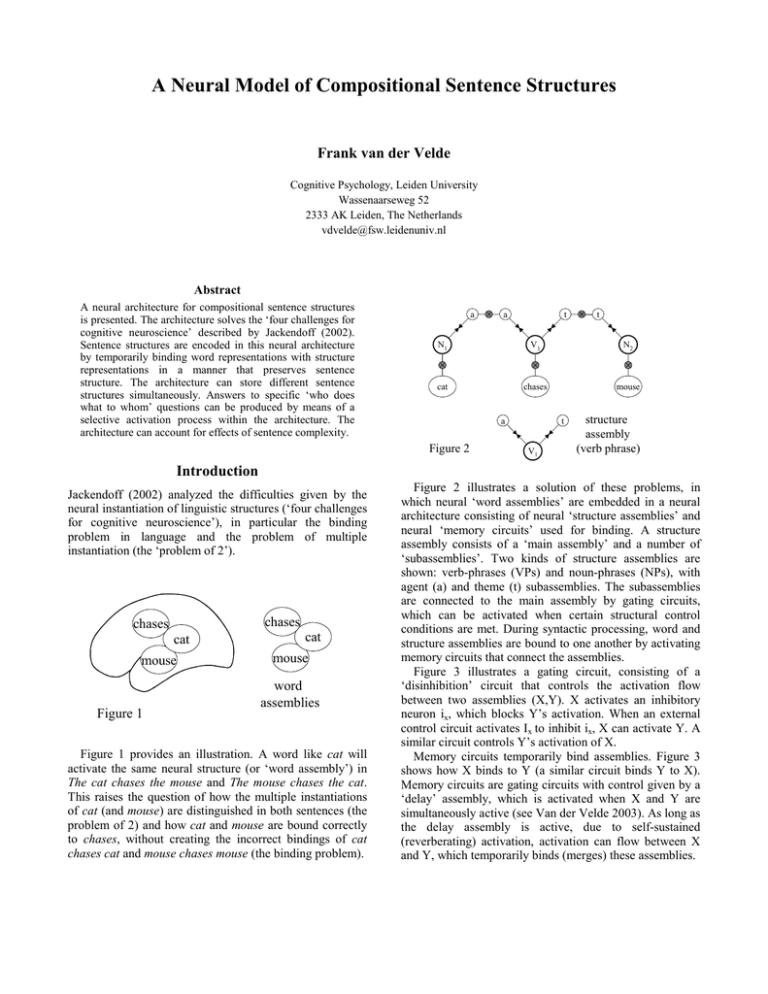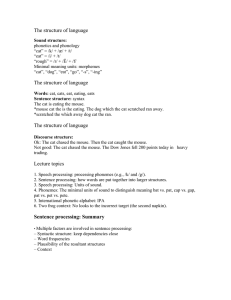
A Neural Model of Compositional Sentence Structures
Frank van der Velde
Cognitive Psychology, Leiden University
Wassenaarseweg 52
2333 AK Leiden, The Netherlands
vdvelde@fsw.leidenuniv.nl
Abstract
A neural architecture for compositional sentence structures
is presented. The architecture solves the ‘four challenges for
cognitive neuroscience’ described by Jackendoff (2002).
Sentence structures are encoded in this neural architecture
by temporarily binding word representations with structure
representations in a manner that preserves sentence
structure. The architecture can store different sentence
structures simultaneously. Answers to specific ‘who does
what to whom’ questions can be produced by means of a
selective activation process within the architecture. The
architecture can account for effects of sentence complexity.
a
a
t
t
N1
V1
N2
cat
chases
mouse
a
Figure 2
t
V1
structure
assembly
(verb phrase)
Introduction
Jackendoff (2002) analyzed the difficulties given by the
neural instantiation of linguistic structures (‘four challenges
for cognitive neuroscience’), in particular the binding
problem in language and the problem of multiple
instantiation (the ‘problem of 2’).
chases
chases
cat
mouse
Figure 1
cat
mouse
word
assemblies
Figure 1 provides an illustration. A word like cat will
activate the same neural structure (or ‘word assembly’) in
The cat chases the mouse and The mouse chases the cat.
This raises the question of how the multiple instantiations
of cat (and mouse) are distinguished in both sentences (the
problem of 2) and how cat and mouse are bound correctly
to chases, without creating the incorrect bindings of cat
chases cat and mouse chases mouse (the binding problem).
Figure 2 illustrates a solution of these problems, in
which neural ‘word assemblies’ are embedded in a neural
architecture consisting of neural ‘structure assemblies’ and
neural ‘memory circuits’ used for binding. A structure
assembly consists of a ‘main assembly’ and a number of
‘subassemblies’. Two kinds of structure assemblies are
shown: verb-phrases (VPs) and noun-phrases (NPs), with
agent (a) and theme (t) subassemblies. The subassemblies
are connected to the main assembly by gating circuits,
which can be activated when certain structural control
conditions are met. During syntactic processing, word and
structure assemblies are bound to one another by activating
memory circuits that connect the assemblies.
Figure 3 illustrates a gating circuit, consisting of a
‘disinhibition’ circuit that controls the activation flow
between two assemblies (X,Y). X activates an inhibitory
neuron ix, which blocks Y’s activation. When an external
control circuit activates Ix to inhibit ix, X can activate Y. A
similar circuit controls Y’s activation of X.
Memory circuits temporarily bind assemblies. Figure 3
shows how X binds to Y (a similar circuit binds Y to X).
Memory circuits are gating circuits with control given by a
‘delay’ assembly, which is activated when X and Y are
simultaneously active (see Van der Velde 2003). As long as
the delay assembly is active, due to self-sustained
(reverberating) activation, activation can flow between X
and Y, which temporarily binds (merges) these assemblies.
control
Ix
Ix
ix
X
ix
X
X
Y
Xout
Symbol:
Y
Nx
Ny
a
t
a
t
NP mainassemblies
Y
Xout
X
Y
(inactive)
X
Y
(active)
Symbol:
gating circuit
Figure 3
Word assemblies (nouns)
delay
agent
subassemblies
theme
subassemblies
memory circuit
Figure 2 illustrates the neural structure of cat chases
mouse in the architecture described here. The assembly for
cat is bound by an active memory circuit to an arbitrary NP
assembly N1. Likewise, mouse is bound to N2, and chases
is bound to a VP assembly V1. N1 is then bound to V1 by
means of their agent subassemblies, and N2 is bound to V1
by their theme subassemblies. The binding process is
controlled by neural circuits (not presented here), that
interpret cat as the agent of chases (activating the gating
circuits for ‘agent’), and mouse as the theme of chases
(activating the gating circuits for theme).
Overview of the Architecture
Figure 4 presents an overview of a neural architecture for
neural sentence structure (in particular for verb-argument
binding). Each word assembly that encodes a noun is
connected to the main assembly of each NP assembly by
means of a memory circuit, which is initially inactive. In
the same manner, each word assembly that encodes a verb
is connected to the main assembly of each VP assembly by
means of an (initially inactive) memory circuit. The main
assembly of each NP or VP assembly is connected to
subassemblies by means of gating circuits (i.e., each NP or
VP assembly has its own set of subassemblies, as illustrated
with V1 in figure 2). Main assemblies and subassemblies
are also delay assemblies, in the sense that they can remain
active on their own. Subassemblies are used to represent
thematic roles, such as agent or theme as illustrated in
figures 2 and 4. They can also be used to represent
syntactic structures such as complements or relative clauses
(as discussed later on). Subassemblies can be used to
represent thematic roles or syntactic structures, because
they are used to connect the NP and VP assemblies. Thus,
all agent subassemblies of the NP assemblies are connected
to all agent subassemblies of the VP assemblies, by means
of (initially inactive) memory circuits. Likewise for the
other kinds of subassemblies.
There is also an inhibitory interaction between the VP
main assemblies, as illustrated with the horizontal bar in
Figure 4. This results in a competition between VP main
assemblies. Likewise for NP main assemblies.
Vi
Vj
VP mainassemblies
Word assemblies (verbs)
Figure 4
The ability to retrieve information (i.e., to answer ‘who
does what to whom’ questions) in this architecture critically
depends on the competition between main assemblies.
Multiple Instantiation
Figure 5 shows the simultaneous encoding of the sentences
The cat chases the mouse, The mouse chases the cat and
The cat bites the dog in the architecture presented in figure
4. The neural structure of The mouse chases the cat in
figure 5 is the same as in figure 2.
The words cat, mouse and chases occur in more than one
sentence in figure 5, and, in the case of cat and mouse, in
more than one thematic role. This creates the problem of
the multiple instantiations of the words cat, mouse and
chases (the problem of 2). Figure 5 illustrates how the
problem of multiple instantiation is solved in the
architecture presented in figure 4. Each word in a sentence
is encoded by binding its word assembly to a unique
structure assembly. For instance, the word assembly for cat
is bound the NP assemblies N1, N4 and N5 in figure 5.
These different NP assemblies bind cat in the different
sentences involved. In this way, cat can be bound as the
agent in one sentence (by N1 or N5 ) and as theme in
another (by N4). Thus, the different NP assemblies encode
cat as different tokens of the same type. Similarly, the
different VP assemblies (V1 and V2) encode chases as
different tokens of the same type.
As illustrated in figure 1, the sentences presented in
figure 5 cannot be encoded in terms of direct associations
between word (noun and verb) assemblies. For instance,
the association of cat-chase-mouse does not distinguish
between the sentences The cat chases the mouse and The
mouse chases the cat, because cat and mouse are not
encoded as agent or theme in these associations.
a
a
N1
t
V1
cat
N2
chases
a
a
N3
t
mouse
a
N5
N4
chases
a
t
V3
cat
Extension of the Architecture
t
V2
mouse
V1 as the winner of the VP competition. This analysis has
been confirmed by pilot simulations, using populations of
spiking neurons to simulate the assemblies (Van der Velde
and de Kamps 2003).
t
cat
t
N6
bites
dog
Figure 5
The internal structure of the NP and VP assemblies,
given by the gating circuits, is of crucial importance in this
respect. Without this internal structure, the neural sentence
structures presented in figure 5 would also consist of direct
associations between neural assemblies, which would
create the same problems as described above, such as the
failure to distinguish between The cat chases the mouse
and The mouse chases the cat.
The architecture solves the problem of 2 because it can,
e.g., bind cat to different NP assemblies (N1, N4 and N5 in
figure 5) in different sentence contexts. It solves the
binding problem, because NP and VP assemblies can bind
through different subassemblies. In this way, cat can be the
agent of chases in one sentence and the theme of chases in
another. Through selective activation, resulting from gating
and memory circuits, questions like “Whom does the cat
chase?” or “Who chases the mouse?” can be answered
correctly. It can be shown that the architecture presented
here provides a solution to all of Jackendoff’s challenges
(see Van der Velde 2003).
a
N1
cat
V1
chases
n
N2
mouse
v
t
V1
N1
cat
chases
N2
mouse
S1
n
v
N1 star
Answering Binding Questions
With the control of activation provided by gating circuits,
the neural structures of encoded sentences can be
selectively (re)activated. Selective reactivation of a
sentence structure in figure 5 is necessary to retrieve
information from the architecture. In particular, to answer
specific binding questions, such as the question “Whom
does the cat chase?”. The question provides the information
that cat is the agent of chases and it asks for the theme of
chases in that sentence (i.e., it asks for x in the sentence cat
chases x). The production of the answer consists of the
selective activation of the word assembly for mouse. This
can be achieved through a competition process between the
VP assemblies, in which V1 emerges as the winner. After
that, the activation of the gating circuits for theme will
result in the activation of N2 by V1, and thus in the
activation of mouse as the answer to the question.
The competition between the VP assemblies is
determined by the information provided by the question,
which results in the activation of the assemblies for cat and
chases, and the gating circuits for agent. Inspection of
figure 5 shows that V1 receives the most activation in this
case, because it is activated by chases and N1 (through cat),
whereas V2 is only activated by chases and V3 is only
activated by N5 (through cat). The mutual inhibition
between VP main assemblies (figure 4) will then result in
S1
t
d
V1 is
adj
pv
D1
Adj1
the
little
P1 beside
pn
N2 star
d
Figure 6
adj
D2
Adj2
a
big
Extension of the architecture is introduced in figure 6.
Figure 6 (top-left) shows a shorthand presentation of cat
chases mouse (omitting gating and memory circuits,
writing words below their structure assemblies). However,
the full structure (figure 2) is always implied: main
assemblies are connected to subassemblies by gating
circuits; subassemblies are bound (merged) by active
memory circuits.
Figure 6 (top-right) shows a more elaborate (shorthand)
structure of cat chases mouse, using a sentence structure
assembly (S1) and noun and verb subassemblies. N1 (cat) is
bound to S1 by noun subassemblies, and V1 (chases) is
bound to S1 by verb subassemblies. Interaction between
noun and verb subassemblies (dotted line) controls
agreement between noun and verb (e.g., cat-chases vs.
cats-chase).
Figure 6 (bottom) shows the (shorthand) structure of The
little star is beside a big star (Jackendoff 2002), with
structure assemblies and subassemblies for adjective,
preposition, and determiner. Different structure assemblies
and subassemblies can be introduced for other syntactic
features (Van der Velde 2003), as illustrated below.
Embedded Clauses and Complexity
Figure 7a presents the structure of the sentence The cat that
bites the dog chases the mouse, with subject-relative clause
that bites the dog. To encode and bind this clause, a new
clause structure assembly (C) is introduced, with a new
clause subassembly (c). C assemblies play a role in the
encoding of a clause that is similar to the role played by S
assemblies in the encoding of the main sentence (cat chases
mouse in figure 7a). The word assemblies of
complementizers can bind with C assemblies, as illustrated
with that in figure 7a. Like S assemblies, C assemblies can
be used to encode agreement between subject and verb
(here, between the subject of the main sentence and the
verb of the relative clause).
that the boy likes bites. Sentences of this type are
notoriously hard to process. The phrase the dog that the
boy is structurally similar to the phrase the cat that the dog,
so that the theme subassembly of N2 (dog) will be activated
as well to bind with the theme subassembly of the next
verb. Thus, when the first verb (likes) appears, there are
two subassemblies that can bind with the theme
subassembly of this verb, whereas the verb should bind
with dog (N2) as its theme argument. The situation is
similar with the second verb (bites). The two problematic
bindings are indicated with the dashed lines in figure 8a.
S1
n
N1
cat
S1
v
c
V3
N4
chases
mouse
t
V2 bites
dog c
N1
cat
c
n
t
V3
N4
chases
mouse
N1
cat
v
c
C1 that
t
V3
N4
chases
mouse
t
V2
bites
(a)
n
N2
dog
N2
dog
N4
surprises
boy
n
v
V2 roars
N2
C2 that
v
N3
boy
t
V1
likes
n
N3
cat
v
t
V1
chases
(b)
(a)
Figure 8
C1 that
v
t
V3
mouse c
n
v
c
C2 that
S1
v
C1 that
v
N2
n
N1
fact
C1 that
n
S1
n
t
v
t
V2
bites
(b)
Figure 7
Figure 7b presents the structure of the sentence The cat
that the dog bites chases the mouse, with the objectrelative clause that the dog bites. Here, dog is the subject
of bites, so it is bound to the noun subassembly of C1, and
agreement between dog and bites is encoded by agreement
between the noun and verb subassemblies of C1. In an
object-relative sentence like The cat that the dog bites
chases the mouse, the subject of the main sentence is the
theme of the verb in the relative clause. In the structure
presented in figure 7b, this is instantiated by the binding of
cat (N1) with bites (V2) by means of their theme
subassemblies. This poses a problem for the control of
binding in this sentence. When V2 is active, N2 is the active
NP assembly, not N1. Therefore, the theme subassembly of
N1 has to be activated before the activation of N2. Thus, the
gating circuits for theme have to be activated before the
activation of the main assembly of N2.
Figure 8a presents the structure of The cat that the dog
that the boy likes bites chases the mouse (1), with the
double center-embedded object-relative clause that the dog
Figure 8b shows the structure of the sentence The fact
that the mouse that the cat chases roars surprises the boy
(2). Here, roars (V2) does not have a theme argument, and
mouse (N2) will bind with the first verb (chases) as its
theme (see Van der Velde 2003). In (1) the subject of the
main sentence (cat) is also the theme of a verb in an objectrelative clause. In combination with the second objectrelative clause, this results in an ambiguity of the binding
of cat (N1) or dog (N2) as the theme of likes (V1) or bites
(V2). In contrast, in (2) the subject of the main clause (fact)
is not bound to any of the verbs in the embedded clauses,
so that the ambiguities in (1) do not arise in (2). This
example shows that the architecture can account for effects
of sentence complexity.
References
Jackendoff, R. (2002). Foundations of language. OUP
Van der Velde, F (2003). Neural blackboard architectures
of
combinatorial
structures
in
cognition.
http://cogprints.ecs.soton.ac.uk/secure/00003196/01/neural
archs.pdf
Van der Velde, F. and de Kamps, M. (2003). Neural
assembly binding in linguistic representation. European
Symposium on Artificial Neural Networks, Evere: d-side.
Copyright © 2004, American Association for Artificial Intelligence
(www.aaai.org). All rights reserved.






